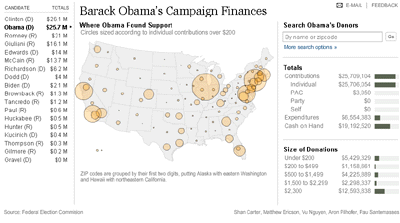I noticed a nifty new feature on The Washington Post's website this afternoon. Campaign Tracker uses information from a variety of sources, including campaigns and media to compile a database that stores information about events where the 2008 presidential candidates will be making appearances.
This feature uses a variety of techniques to keep things organized. Campaign events are stored on Google Maps, which makes getting directions and pinpointing locations quite easy. In addition, the Campaign Tracker allows users to filter events by candidate, date, and state, which makes sorting and searching the events simple.
The Campaign Tracker is an interesting and useful tool, and it is something that you don't often see on newspaper websites. The Campaign Tracker is creative, and provides a new way at looking at the 2008 Presidential campaigns.
The Washington Post seems to have a knack for creating this type of niche content. In the 2006 Senate cycle, the paper built a database for storing and displaying political ads produced by all the various campaigns. This feature, called Mixed Messages, provides WashingtonPost.com readers with a centralized location where they can watch and compare all of the political ads produced by campaigns around the country.
The WaPo isn't alone in its endeavors, however. The New York Times has gotten into this process by launching its database for campaign finances about a month ago, which uses a map application to show the fundraising stats for all of the presidential candidates.

I would like to see more newspapers experiment with this kind of tool. While it's definitely outside of their core competencies, I think that this type of coverage helps fill a niche where regular people otherwise have difficulty finding information. By filling these gaps with tools like those the WaPo and New York Times have developed, these publications can be a prime source for specific news.
Sign up today to have our latest posts delivered straight to your inbox.